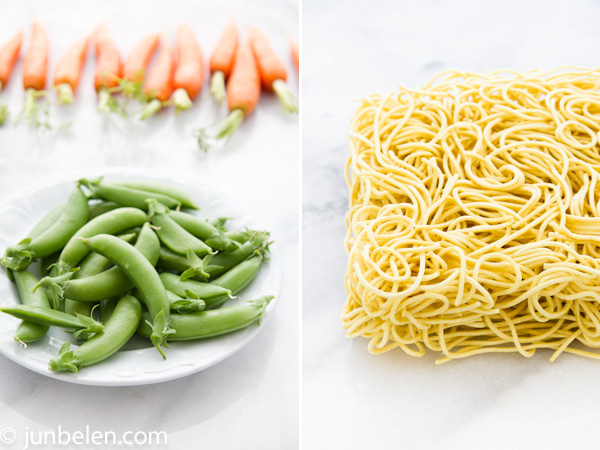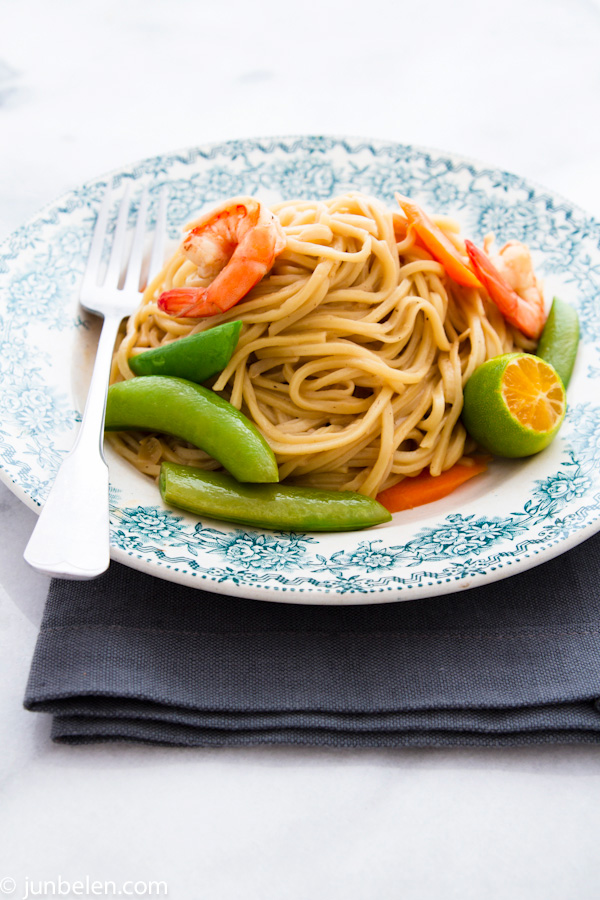With one snip a pair of plump pods fell into my bowl. They were as round and as long as my ring finger. Skins were spotless. Unblemished. The sugar snap peas that we planted from seeds in February had grown heftily into a bush in the garden. It was heavy with fruit, standing just over two feet tall with a little help from a pair of stakes that we crisscrossed and tied together loosely.
I pinched off the ends of one of the pods with my fingers and tasted my harvest. Crisp and sweet. They are called sugar snap peas for a reason. A very good reason. Sweet as sugar. And the fact that they were homegrown made them taste even sweeter. The bowl of peas could just as easily have been my afternoon merienda but I held back. I wanted them for dinner. I thought about stir fried sugar snap peas. Seared in hot oil for a minute or two and not a moment longer so that they stay vividly green and crisp. Tossed with salt, pepper, and red chili flakes.
Then I thought about the unopened package of pancit Canton noodles sitting in my pantry and the chicken stock I made the other day from chicken bones I roasted in the oven. Stir frying the sugar snap peas with noodles seemed like a far better use of my spring harvest. Pancit is a staple at home and I make fried noodles with whatever vegetable I have at hand. Carrots and cabbages year-round. Green beans in the summer. Brussel sprouts in the fall. Asparagus in the spring. Pancit Canton with peas grown from our garden would be a splendid tribute to the passing of spring.
I picked the last remaining pods and as I headed back to the kitchen I stopped and snipped a few limes from our calamansi tree. A squeeze of citrus would complete our feast.
Pancit Canton Recipe, makes 4 to 6 servings
3 tablespoons vegetable oil
2 cloves garlic, crushed
1 small onion, thinly sliced
1/2 pound shrimp, shelled with tails on, and deveined
1 boneless chicken breast, boiled and shredded
1 medium carrot, thinly sliced crosswise, about 3/4 cup
1/4 pound sugar snap peas, ends trimmed, about 1-1/2 cups
2 to 3 cups chicken stock
2 tablespoons soy sauce
1 tablespoon fish sauce
1 8-ounce package dried pancit Canton noodles
sea salt and freshly ground black pepper to taste
2 calamansi limes
Heat oil in a wok or large pan over medium-high heat. Saute garlic until lightly browned. Add onions and saute until fragrant and softened. Add shrimp and stir fry until cooked. Add chicken and stir fry until well combined. Transfer meat to a large bowl and set aside. Add more oil to the hot pan. Add carrots and stir fry for a few minutes. Add sugar snap peas and stir fry for a couple minutes more. Transfer vegetables to the bowl with the meat and set aside.
Pour chicken stock into the pan and bring to a boil. Add Canton noodles, soy sauce, and fish sauce. Turn the heat to medium and let the noodles simmer, stirring frequently until approximately 1/4 cup stock remains. Add the meat and vegetables back into the pan and stir fry everything together until all the stock has boiled off. Add salt and pepper to taste. Serve with a squeeze of calamansi.
Cooking Notes
1. Stir fry the sugar snap peas only briefly, about two or three minutes, so the peas stay green and crisp.
2. Packaged, dried Canton noodles available in most Asian stores are made of flour. Fresh Canton noodles are made of eggs. Use less chicken stock when cooking with freshly made noodles.
3. The origin of the name of the dish is not completely understood. Clearly, the name pays tribute to the technique of stir frying, which is Chinese, but other Filipino noodle dishes like bihon (rice noodles) and sotanghon (mung bean noodles) employ the same cooking technique.

